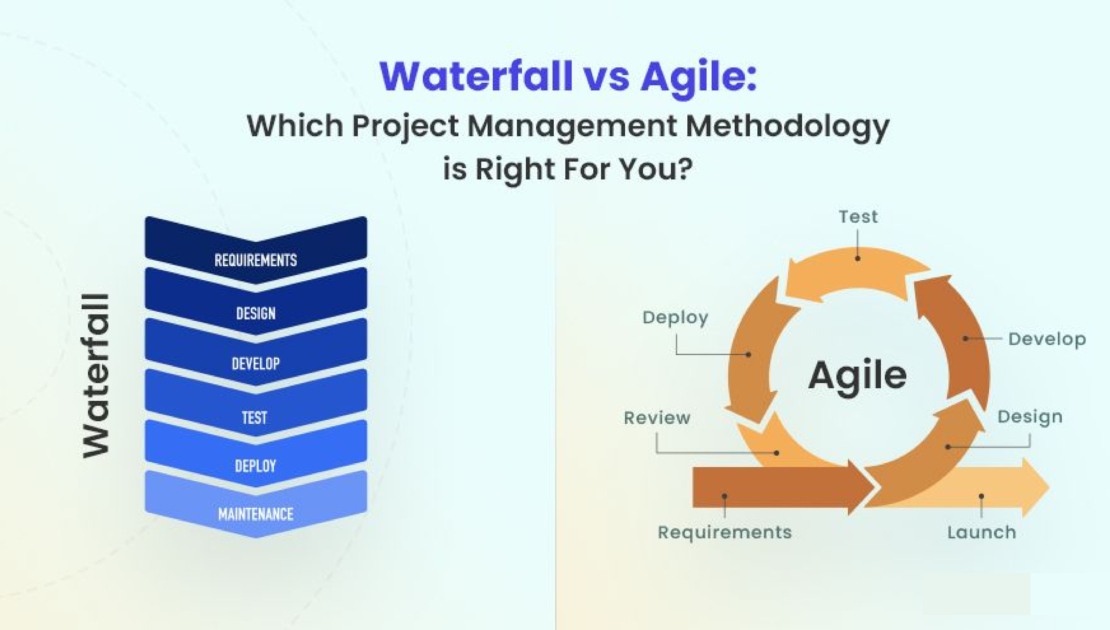Introduction: In the dynamic world of IT, choosing the right project management methodology is crucial for successful and timely project delivery. Two prominent methodologies, Agile and Waterfall, have been at the forefront of project management discussions for years. In this blog, we’ll delve into the key differences between Agile and Waterfall methodologies, explore their respective pros and cons, and analyze which methodology is better suited for the ever-evolving IT industry in the 21st century. Additionally, we’ll ponder the impact of AI on project management and the future landscape of methodologies.
Agile Methodology:
Agile is a flexible and iterative approach to project management, emphasizing collaboration, adaptability, and customer satisfaction. It breaks down projects into small increments, called iterations or sprints, allowing teams to respond to changing requirements quickly. This iterative process encourages constant communication between team members and stakeholders, fostering a more responsive and dynamic development environment.
Pros of Agile Methodology:
- Flexibility: Agile allows for changes to be made even late in the development process, accommodating evolving client needs.
- Customer Satisfaction: Continuous collaboration with stakeholders ensures that the end product aligns with customer expectations.
- Faster Time-to-Market: Incremental development and frequent releases enable quicker delivery of usable components.
Cons of Agile Methodology:
- Lack of Predictability: The fluid nature of Agile can make it challenging to predict the final outcome accurately.
- Resource Intensive: Agile requires active involvement and constant communication, which can be resource-intensive.
Waterfall Methodology:
Waterfall is a linear and sequential approach to project management, where each phase must be completed before the next begins. It is a more traditional and structured model, making it easier to plan and manage projects with well-defined requirements.
Pros of Waterfall Methodology:
- Predictability: The rigid structure of Waterfall makes it easier to predict timelines and resource requirements.
- Clear Documentation: Each phase has defined deliverables, leading to comprehensive documentation throughout the project.
Cons of Waterfall Methodology:
- Limited Flexibility: Changes are difficult to implement once a phase is complete, making it less adaptable to changing requirements.
- Late Feedback: Stakeholder feedback is typically received late in the process, potentially leading to misunderstandings or dissatisfaction.
Choosing the Right Methodology for the 21st Century IT Industry:
The choice between Agile and Waterfall depends on various factors such as project complexity, client involvement, and the ability to adapt to change. In the fast-paced IT industry, Agile’s flexibility and emphasis on collaboration often make it the preferred choice for projects with evolving requirements and dynamic environments.
The Future After AI: As Artificial Intelligence continues to shape the IT landscape, the role of project management methodologies is also evolving. AI can enhance project planning, resource allocation, and decision-making processes. Agile methodologies, with their adaptability and focus on collaboration, may be better suited to integrate AI technologies seamlessly.
Conclusion: In the 21st-century IT industry, the choice between Agile and Waterfall methodologies depends on the specific needs and characteristics of each project. While Waterfall provides predictability and structure, Agile offers flexibility and responsiveness. As AI continues to advance, methodologies that can seamlessly incorporate these technologies will likely become the standard. The key lies in staying adaptable, embracing change, and choosing the methodology that aligns best with the unique demands of each project in this era of constant innovation.

